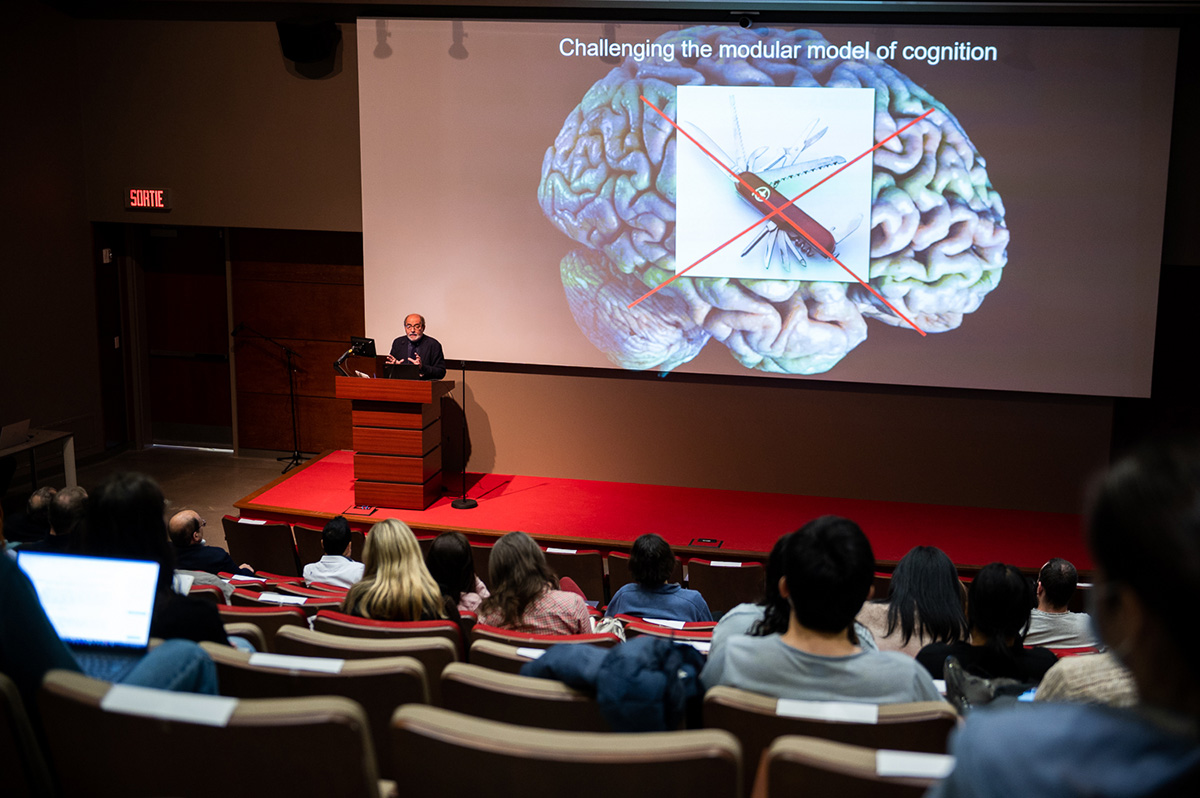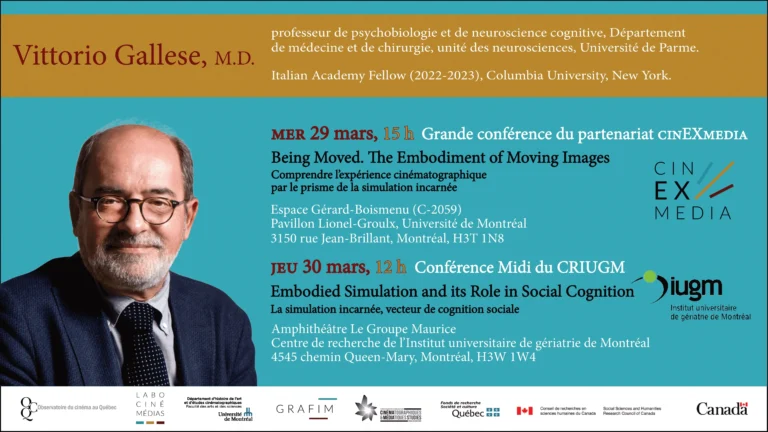The professor of psychology and cognitive neuroscience Vittorio Gallese, a member of cinEXmedia, inaugurated a new series of lectures for the partnership
Olivier Du Ruisseau and Lou Andrysiak
The cinEXmedia Distinguished Speaker series was inaugurated by the cinEXmedia partnership on 29 March. At this event, held in the Lionel Groulx pavilion of the Université de Montréal, the Italian researcher and professor Vittorio Gallese presented his most recent research into the way in which the cinema experience can be studied using models from neuroscience.
Entitled “Being Moved: The Embodiment of Moving Pictures,” this inaugural lecture was followed the next day by a second presentation by professor Gallese, at the Centre de recherche de l’Institut universitaire de gériatrie de Montréal (CRIUGM).
His second talk, entitled “Embodied Simulation and Its Role in Serial Cognition,” took a broader view of the analysis of social interactions from a neuroscience perspective. In it, professor Gallese examined the ways in which empathy develops in the human brain and how our relations with others shape the construction of our identity and our conception of the self.
Cinema and the Neurosciences
“The human body plays a central role in social cognition,” Vittorio Gallese concluded at the end of his lecture on 30 March. “It is one of the only things of which I am absolutely certain. Our body creates unconscious intrinsic conditions which determine our experience of the world.”
This observation underlies the complex neuroscience models defined by Gallese in his two presentations, which were received with great enthusiasm by the Montreal public.
In his 29 March lecture, professor Gallese explained how, in his view, “body-brain interactions” are activated in a precise manner when we are confronted with cinematic images. He believes that cinema gives rise to reactions in individuals similar to those observed in direct social interactions between people. This, at least, is what he sought to demonstrate in his book The Empathic Screen: Cinema and Neuroscience, which he co-authored with Michele Guerra and which was published by Oxford University Press in 2019.
Vittorio Gallese’s field of study, at the intersection of cinema studies and the neurosciences, remains relatively unusual. He thus took the time to explain his methodology to his audience during his lecture at the Université de Montréal. This led him to mention, among other things, that he had used electroencephalography to measure the response of his students’ brains when watching certain film scenes. He agreed, however, that it was almost impossible to understand how every potential factor, such as the environment in which the tests are carried out and the subjects’ emotions before being tested, might influence the results.
These challenges are seen by Gallese above all as promising avenues for future research. Even so, the “embodied simulation” model, as it is applied to cinema by professor Gallese, remains profoundly innovative, and his experiments are unique in the world.
A “New Age of Collaboration”
The cinEXmedia partnership, under whose aegis Vittorio Gallese’s lectures took place, is a research infrastructure within the CinéMédias research laboratory at the Université de Montréal. The partnership is carried out jointly with interdisciplinary research groups around the world.
According to Santiago Hidalgo, a professor in the Département d’histoire de l’art et d’études cinématographiques at the Université de Montréal and Executive Director of the partnership, cinEXmedia makes it possible to better understand “the role our experiences of cinema play in our lives on different levels.” He thus hopes to “study the role of these experiences in society in order to create more inclusive communities by developing programs to make cinema more accessible to a variety of audiences.”
This postulate, expressed at a reception following the lecture on 29 March, is a reference to the various initiatives put in place by the partnership. Isabelle Raynauld, co-director of cinEXmedia, mentioned one of her documentary projects in preparation during the evening. In this new project, she will be looking at the influence of opera on the brain in different groups of people. This film will complete a trilogy of documentaries focusing on the study of brain activity, with De la musique pour le cerveau (Raynauld, 2019) and Le cerveau mystique (Raynauld, 2006).
At this event, the chair of the Département d’histoire de l’art et d’études cinématographiques at the Université de Montréal, Bernard Perron, emphasized for his part the “space for dialogue and sharing” that cinEXmedia represents. André Gaudreault, co-director of the partnership, and Éric Montpetit, Associate Dean of the Faculté des arts et des sciences, also paid tribute to the innovative nature of the partnership’s work.
Marie-Josée Hébert, Deputy Rector for Research, Discovery, Creation and Innovation, underscored the importance of cinEXmedia for the Université de Montréal. For her, “this eminently human experience” makes it possible to “explore as never before the keys to cinema” and to usher us into a “new age of collaboration.”


